PROVIDENCE, RHODE ISLAND
April 23, 2010
STRANGER: Robin Tafel
LOCATION: Camille’s, 71 Bradford Street, Providence, Rhode Island
THEME: Dinner with a design student
Where am I going?
That thought kept recurring on a Friday night in Providence ahead of my dinner date with stranger Robin Tafel. I didn’t know much about her, not even what she looked like. And I most definitely had no clue where were we going to have our dinner interview because we had yet to agree on a place.
The only certain things: it was Friday night, it was breezy, and I was leaning against the wall of a shuttered Dunkin’ Donuts on a street corner in the city’s Federal Hill neighborhood. Yeah, that’s how I roll on Friday nights, chilling by the long-closed donut shop.
Thankfully after a few minutes I spotted a young woman walking toward me and calling my name. Even more thankfully, it was Robin and not some random crazy person who successfully guessed my moniker. After a quick hello, we started wandering the area to try and figure out where to eat. Let me tell you, if you ever find yourself in Federal Hill you better have an appetite for Italian food, because they’re the predominant establishments.
So it was that we settled relatively quickly on Camille’s, which is tucked away on a side street with naught but a simple neon sign to lure diners in.
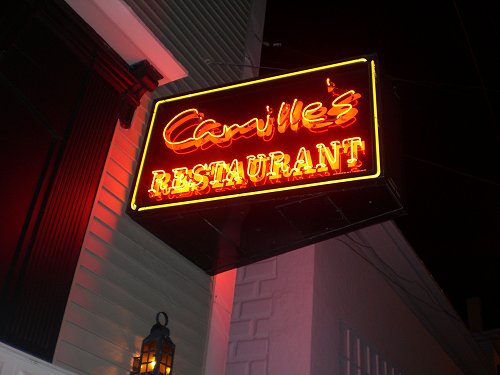
After scanning the menu — and playing trombone with it because of the high prices on some of the dishes — we agreed that this would be fine, and took a table. Well, not literally took a table, because that would be ludicrous, but we sat down to eat.
Robin seemed a little reserved to begin with, completely understandable given that she sat down to a dinner table with a random man from another town. Regardless from the start she was pleasant company, with a quiet, light way of speaking that’s easy to listen to. As dinner went on, she also seemed to relax and kept the conversation flowing.
I sometimes wonder why people are willing to take part in this site, and I figure a few interviewees do it because they’re natural communicators. With Robin, this makes perfect sense. She’s a soon-to-graduate graphic design student in Rhode Island and has an ever-developing goal of using art as a means to communicate with the public.
Robin, 25, is enrolled at the Rhode Island School of Design (commonly referred to as RISD) and in June will get her Bachelor of Fine Arts degree. Now she’s wrestling with the same question I had at the start of the night — where am I going? — but on a much bigger scale as she tries to figure out where to move and what career to pursue.
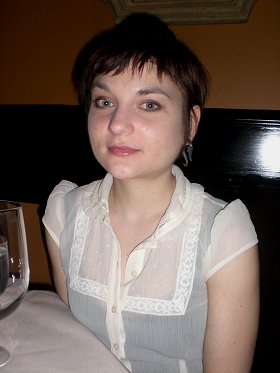
As we settled in and perused the menu, I let Robin pick a wine. She settled on a Santa Margherita pinot grigio for $55. Not bad, and after having a sip, well worth the price.
After placing our orders, Robin gave me her mini-history. Born in California, she was primarily into gymnastics till about the age of 15 when she had to quit because of an injury. She had always been interested in art because her mother is an artist and architect, so after leaving the world of gymnastics she delved into art and design. Robin got an associates degree in graphic design in the Golden State, and after working some jobs, transferred to RISD.
And now you know the rest of the story.
Well, not quite. Elaborating on her early introduction to art, Robin said that when she young her mother “always had us doing crafts, painting, she always had out paint supplies” that Robin would play with. “She was also a very talented painter,” she said, with her mother taking part in a decorative painting group with friends. “She was the rebel that would change the patterns and do her own drawings and piss the teachers off,” Robin said with a grin.
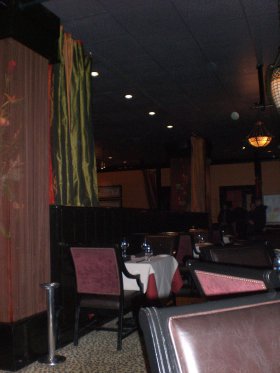
Being around all that art made it seem like a natural thing to explore further at school while still in California, and Robin stepped up her efforts painting, drawing “and really just making art.” But she was “anti-computers and I really didn’t know what was so great about graphic design. It didn’t interest me. I was a traditional painter.”
That changed when Robin moved out of her parents’ house the summer before her senior year of high school, when she experience a “bitter taste of reality” having to pay rent and other bills. So she got a job with a portraiture studio in California. Their work sounded highly elaborate: according to Robin they would take photos, composite them with fancy backgrounds to make them look like classical paintings, manipulate them on the computer, print them on to canvas, seal them, and then paint on top of them with oils. Wow. Robin was hired because of her painting experience, and was trained on computers as part of the job.
That’s where she learned about digital photography and software, and also came to a more basic realization that the assistant-level wages she was getting at the job would jump significantly if she had an actual degree in graphic design.
So, Robin got a two-year graphic design degree in California then started looking at four-year schools out of state. But then her father gave her mother divorce papers. “My mom and I are are really close, and it was a bad time to leave.” She stayed in California for about eight months, then applied to a number of schools in New York and also to RISD.
Why Providence?
A good question, but before Robin had chance to answer we were interrupted by the starters. I opted for the rather traditional but basic caprese salad.
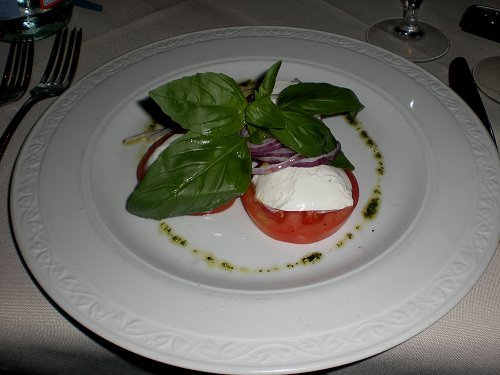
Camille’s bills this $10 dish as “creamy fresh mozzarella over beefsteak tomatoes with red onion and pesto drizzle.” It was a very middle-of-the-road dish. Everything on the plate was so cold that the taste had been frozen out, and while it wasn’t bad, it wasn’t memorable either.
Robin had much more luck with her adventurous appetizer of raw fish.
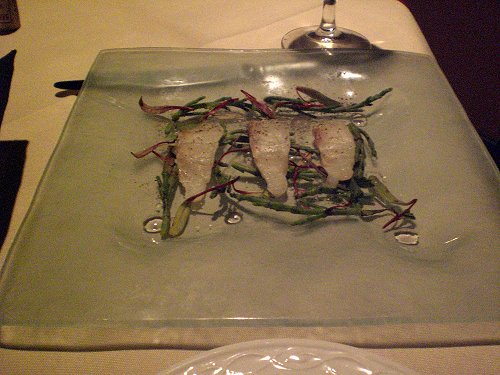
She picked a $9 Red Sea Bream, which Camille’s online menu helpfully explains as being a festive occasion fish in Japan that has a mild flavor. It was served with a “coral dream” of sea beans (what the deuce are those? I still don’t know), micro orchid petals and violet syrup.
I’ll let Robin review the dish in her own words. “It’s subtly salty. It’s like mackerel divided by 12 in terms of potency of flavor. The saltiness is really nice with the lavender syrup because it’s sweet.” There you have it, two thumbs up for that dish.
As the plates were taken away Robin picked up the lingering question about her move to Rhode Island. She said that it made more sense than New York schools because living in Manhattan just seemed so cost-prohibitive. Besides, there is a “great art subculture” in Providence, she said.
At school she takes part in a variety of classes including typography, which teaches the proper and creative uses of fonts, quotations marks, and more. There are several other classes, but it seemed like Robin was most into classes where she could learn about art as a narrative.
“Now is the time to do something a little selfish”
“Designers are in essence communicators, so the class is about how to use those principles to communicate your ideas. You could say semiotics is everything. You have a mode of sending the message that is your art, then you have the message itself, and the person receiving it,” she said.
One example of such work Robin undertook is a global warming poster design, which she became heavily invested in because it fits in with her goal of using design for “social change and positive reasons.”
Her idea was based on the theme of plastic surgery, and what people might do to their own bodies to fit in decades from now with a different climate. She used Photoshop to manipulate a picture of herself into the standard plastic surgery image — a different nose, Botox, and more, and labeled that picture plastic surgery in 2010. Then she manipulated the same photo but this time set in 2030, when global warming might have put some big cities underwater. So the surgery in this photo was the addition of fish eyes, gills on her neck and a fish mouth.
Robin said she got a good reception to the posters, and the concept of combining graphic design with advocacy is something she said will continue. “When I graduate I’ll have all sorts of pro bono opportunities to do posters for campaigns. Now’s the time do something a little selfish, to figure stuff out and to amuse myself,” she said.
Before we had chance to delve into her final year project, the main courses arrived. First up was the $25 lasagne that I ordered.
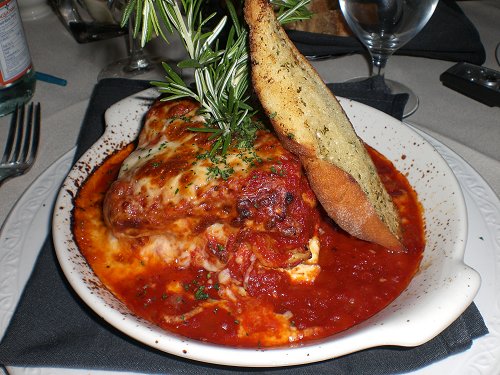
Camille’s touts this as its “famous” lasagne. Looks more like a famous brick. Seriously, the thing was huge. If I’d thrown it at someone’s head, it’d have knocked them out. But I don’t hurl my dinners around, so I tucked in. And it was delicious. The dish has pasta, Bolognese sauce, mozzarella, meatballs, sausage and ricotta cheese, and comes with a slice of garlic toast. The lasagne was soft, the meat tender, and the overall experience outstanding. Worth the price.
Robin ordered the “Scallop Giovanni” for $39.
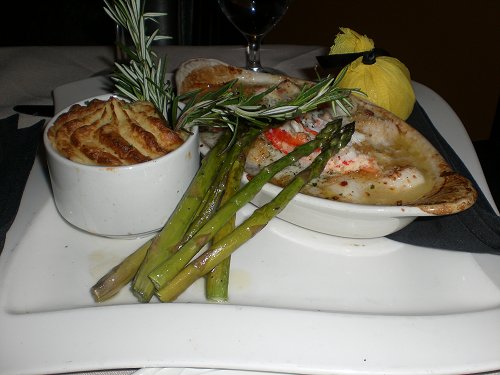
I’ll once again refer to Camille’s menu description of the dish. It’s baked sea scallops alla Giovanni,” which apparently means lightly coated with a crumb topping, garlic butter, mozzarella, lemon, wine, and Alaskan King Crab. Robin seemed to greatly enjoy the dish, a fact confirmed by her one-word description of it: “Awesome.”
As the wine flowed and we plowed through our huge dishes, Robin elaborated on her final year design project.
Her idea came from noticing “shadows and strange subtle unintentional phenomena like reflections. They almost have this entity and yet they don’t. I started describing this as a non-thing, and exploring the idea of not-things versus things.” She started delving into metaphysics, and questions of what it means to exist. “How do you capture the overlooked and unintentional and utilize that as part of your designs? You can’t define it, but I like questioning it and looking at it,” Robin said. And so she is working on an instalation on that theme.
Robin’s mother is helping out with the architectural design of the installation, and her professors are receptive to the overall concept. “At RISD it’s a good time to do stuff people don’t get. It’s a good sounding board. The professors are good about hearing our weird ideas.”
Besides, Robin said her first job will likely be at a design firm that isn’t doing the social change projects she wants to do full-time, and so “just to not go crazy” she will be doing her preferred art in her own time. “Design for social change will be my night job forever.”
Back to the question that underpinned the evening: where am I going? Where is Robin heading after she graduates? She said there are several options — Boston, New York, a year overseas — but most likely she’ll move back to the San Francisco area.
Her mother has a space she could rent out to Robin, and “I’m a tiny bit homesick and just need to get grounded and figure out what I really want to do next. I don’t want to put my roots down anywhere because I’m young and not attached to anywhere or anyone.
Side note: I forgot to get a photo at the dinner table, so we had to get one after dinner. We had both had a bit of wine by this point and not really feeling a photo, so it came out a bit awkward.

Told you so. Anyway, let’s move on.
Robin said she still gets on well with her mother, and as the dinner wrapped up I realized that Robin’s lifelong interest in graphic design, her independent streak and her mild desire to be back home all speak to one thing: similarities with her mother that reflect a strong bond. It’s obvious that Robin thinks the world of her mother, and vice versa, and it’s only natural that the parent’s love for art got passed down to the next generation. It’s a continuation of a passion.
But that’s my interpretation. Robin sees herself simply as a designer.
“If I make art it’s through the lens of design. I’m not interested in personal work, because I can’t not communicate. I don’t have any interest in interpreting my own feelings and work. My interest lies in communicating ideas to the public.”
Robin is aware that to start with she might not have a lot of say in the work she days, because she will need to pay the bills. But she hopes that eventually she’ll be working full time on social change design. “Hopefully I’ll end up doing more of the stuff I believe in and less of the stuff that just makes money,” she said.
f55zzz